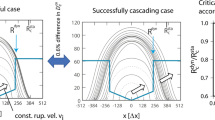Abstract
Based on the theoretical expression of the three-dimension rheologic inclusion model, we analyze in detail the spatio-temporal changes on the ground of the bulk-strain produced by a spherical rheologic inclusion in a semi-infinite rheologic medium. The results show that the spatio-temporal change of bulk-strain produced by the hard inclusion has three stages of different characteristics, which are similar to most of those geodetic deformation curves, but those by a soft inclusion do not. The α-stage is a long stage in which the precursors in both the near source region and the far field develop from the focal region to the periphery. The β-stage indicates a very rapid propagation of the precursors, so that they almost appear everywhere. During the γ-stage, the precursors in the far-field converge from the periphery, and the precursors in the near source region develop outwards. The theoretical results have been used to explain tentatively the stage characteristics of the spatio-temporal change of earthquake precursors.
Similar content being viewed by others
References
Aki K, Richards P G. 1980. Quantitative Seismology: Theory and Methods [M]. San Francisco: W. H. Freeman, 50–57.
Brady BT. 1974. Theory of earthquake [J]. Pure Appl Geophys, 112(4): 701–725.
Dobrovolskii I P. 1991. Theory on the preparation of tectonic earthquakes [M]. Moscow: Ivz. An SSSR, 1–218 (in Russian).
Eshelby J D. 1957. The determination of the elastic field of an ellipsoidal inclusion and related problem [A]. Proceedings of the Royal Society [C]. A241: 376–396.
FENG De-yi. 1983. Three-stage development process of earthquake precursors: observation and theory [J]. Journal of Seismological Research, 6(2): 211–226 (in Chinese).
Kasahara K. 1979. Migration of crust deformation [J]. Tectonophysics, 52: 329–341.
LI Xuan-hu. 1981. Phenomena of diffusion and contraction of water-radon precursors [J]. Earthquake, (5): 340–357 (in Chinese).
MEI Shi-rong. 1994. A study on the physical model of earthquake precursor field and the mechanism of precursors’ time-space distribution — origin and evidences of the strong body earthquake-generating model [J]. Acta Seismologica Sinica, 7(3): 273–282.
MEI Shi-rong, Zhu Yue-qing. 1992. Earthquake-generating Model of the Tangshan Earthquake [M]. Bei**g: Seismological Press, 30–41 (in Chinese).
MEI Shi-rong, FENG De-yi, ZHANG Guo-min, et al. 1993. Introduction to Earthquake Prediction in China [M]. Bei**g: Seismological Press, 241–263 (in Chinese).
Mesherikov J A. 1968. Recent Crust movements in seismic region: Geodetic and geomorphic data [J]. Tectonophysics, 6: 29–39.
SONG Zhi-**. 1996. On the Spatial Temporal Evolution of the Load/Unload Response Ratio (LURR) and Other Earthquake Precursors and Their Implications [D]. [Ph D. Thesis]. Bei**g: Institute of Geophysics, China Seismological Bureau, 15–110 (in Chinese).
WANG **n-hua. 1984. Fault extending before the main rupture and geo-electricity precursors [J]. Scientia Sinica (Series B), (11): 988–998 (in Chinese).
WANG **n-hua, BAI Wu-ming, TENG Chun-kai. 1989. A study on rheological mechanics of seismogenic process [A]. In: Editorial Board of Acta Geophysica Sinica eds. Geophysics in China in the Eighties — In commemoration of the 80th Birthday of Professor Fu Cheng-yi [C]. Bei**g: Science Books and Periodicals Press, 217–230 (in Chinese).
WANG Ren. 1979. Base of Solid Mechanics [M]. Bei**g: Geological Press, 1–90 (in Chinese)
YIN **ang-chu, ZHENG Tian-yu. 1982. Rheological model of earthquake generating process [J]. Scientia Sinica (Series B), (10): 922–930 (in Chinese).
Fujii Yoichiro. 1974. Relationship between duration time of anomalous vertical deformation of the crust and magnitude before the occurrence of an earthquake [J]. Earthquake, 27(3): 197–213 (in Japanese).
ZHANG Guo-min. 1987. Application of rock Rheologic model to earthquake-generating process and precursors [J]. Acta Seismologica Sinica, 9(4): 384–391 (in Chinese).
ZHENG Zhi-zhen. 1979. On generation process of the Tangshan earthquake basing on water-level filtered data [J]. Acta Geophysica Sinica, 22(3): 267–280 (in Chinese).




